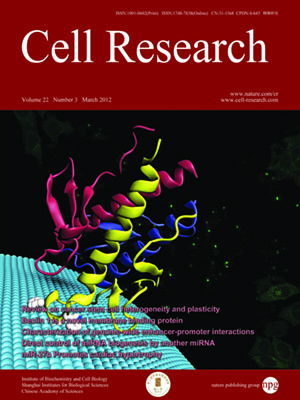
Volume 22, No 3, Mar 2012
ISSN: 1001-0602
EISSN: 1748-7838 2018
impact factor 17.848*
(Clarivate Analytics, 2019)
Volume 22 Issue 3, March 2012: 551-564
ORIGINAL ARTICLES
TRPV1 activation improves exercise endurance and energy metabolism through PGC-1α upregulation in mice
Zhidan Luo1,*, Liqun Ma1,*, Zhigang Zhao1, Hongbo He1, Dachun Yang1, Xiaoli Feng1, Shuangtao Ma1, Xiaoping Chen1, Tianqi Zhu1, Tingbing Cao1
1Center for Hypertension and Metabolic Diseases, Department of Hypertension and Endocrinology, Daping Hospital, Third Military Medical University, Chongqing Institute of Hypertension, Chongqing 400042, China;
2KU Leuven, Department of Molecular Cell Biology, Laboratory Ion Channel Research, Campus Gasthuisberg, Herestraat 49, B-3000 Leuven, Belgium;
3Institute of Vascular Medicine, Li Ka Shing Institute of Health Sciences and School of Biomedical Sciences, Chinese University of Hong Kong, Hong Kong, China
Correspondence: Zhiming Zhu, Zhencheng Yan,(zhuzm@yahoo.com; zhenchengyan@sina.com)
Impaired aerobic exercise capacity and skeletal muscle dysfunction are associated with cardiometabolic diseases. Acute administration of capsaicin enhances exercise endurance in rodents, but the long-term effect of dietary capsaicin is unknown. The capsaicin receptor, the transient receptor potential vanilloid 1 (TRPV1) cation channel has been detected in skeletal muscle, the role of which remains unclear. Here we report the function of TRPV1 in cultured C2C12 myocytes and the effect of TRPV1 activation by dietary capsaicin on energy metabolism and exercise endurance of skeletal muscles in mice. In vitro, capsaicin increased cytosolic free calcium and peroxisome proliferator-activated receptor-? coactivator-1a (PGC-1α) expression in C2C12 myotubes through activating TRPV1. In vivo, PGC-1α in skeletal muscle was upregulated by capsaicin-induced TRPV1 activation or genetic overexpression of TRPV1 in mice. TRPV1 activation increased the expression of genes involved in fatty acid oxidation and mitochondrial respiration, promoted mitochondrial biogenesis, increased oxidative fibers, enhanced exercise endurance and prevented high-fat diet-induced metabolic disorders. Importantly, these effects of capsaicin were absent in TRPV1-deficient mice. We conclude that TRPV1 activation by dietary capsaicin improves energy metabolism and exercise endurance by upregulating PGC-1α in skeletal muscles. The present results indicate a novel therapeutic strategy for managing metabolic diseases and improving exercise endurance.
Cell Research (2012) 22:551-564. doi:10.1038/cr.2011.205; published online 20 December 2011
FULL TEXT | PDF
Browse 2527


